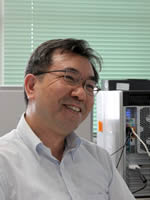Mr. Jianqin Wang (China)
PERSON
October 2014
Mr. Jianqin Wang (China)
Professor of Department of Computer Science and Engineering of Graduate School of Engineering

After I worked six years in industry / university in the development of wireless communication transceivers, I joined NITech (Nagoya Institute of Technology) as a Research Associate in 1997. The following eight years were just the period of rapid spread of mobile phones, which attracted much public attention about possible health risks of electromagnetic fields from cellular phones.
The current knowledge tells us that there are mainly two types of biological effects of electromagnetic fields. One is the stimulation effect to nevus due to induced current in tissue. The other is the thermal effect due to energy absorption in tissue. In the frequency bands of wireless communications, we mainly need to quantify the energy absorption as an electromagnetic compatibility (EMC) issue for evaluating its safety. The quantification of energy absorption in the human body is known as dosimetry. The most important quantity of dosimetry is the specific absorption rate (SAR), defined as the absorbed power per unit mass in unit of watt per kilogram. My study in the first eight years in NITech focused on numerical dosimetry techniques for cellular phones. The research results contributed not only to clarify the SAR level in anatomically based human body models but also to the international standardization of SAR measurement methods.
However, the human safety or risk evaluation of wireless communication technologies is actually a social problem. It is impossible to prove an absolute safety for any type of technologies. At the same time of continuously monitoring the newest research results on possible biological effects of wireless communication technologies, we should reasonably manage the relationship between their obvious merits and possible risks.
Recently, various emerging wireless technologies are appearing and corresponding EMC evaluation is required. The emerging wireless technologies mainly involve various body-centric communications such as body area networks (BAN) for medical and healthcare applications, wireless power transmission and so on. For the SAR evaluation of cellular phones, the world has invested a lot of money and human power into this issue for establishing a reasonable standard and evaluation procedure. Applying the same approach to each emerging wireless technology is obviously inefficient. It is therefore very important to link the fundamental research, product development and standardization together from the EMC point of view.
Since 2005 I was appointed as a professor, I have changed from EMC evaluation to EMC design. The current technology progress and product cycle do not allow us to conduct the EMC evaluation after the wireless technology has been put into market. The EMC evaluation should be made in the design stage, and each wireless engineer should have the basic knowledge to make his/her design meet the existing EMC standards.
I attempted this approach in developing our wireless ECG in NITech. The wireless ECG can detect and transmit ECG signals in a real time to a PC based on human body communication technology. The data rate reaches 1.2 Mbps. My six-year experience in communication hardware development and eight-year experience in bio-EMC evaluation seem very helpful in this approach. During the design process, we have paid much attention to the EMC issue in order to ensure the human safety and to meet the corresponding standards.
NITech provides a very good platform to study and research in this area. In September 2014, we established a project institute, Bio - Electromagnetic Environment Research Institute with researchers of external organizations and companies. It is expected to bring up future wireless engineers who have excellent bio-EMC design ability for various emerging wireless products.

 Japanese
Japanese